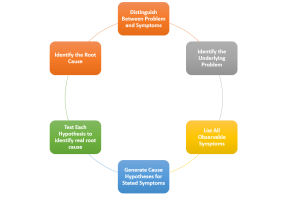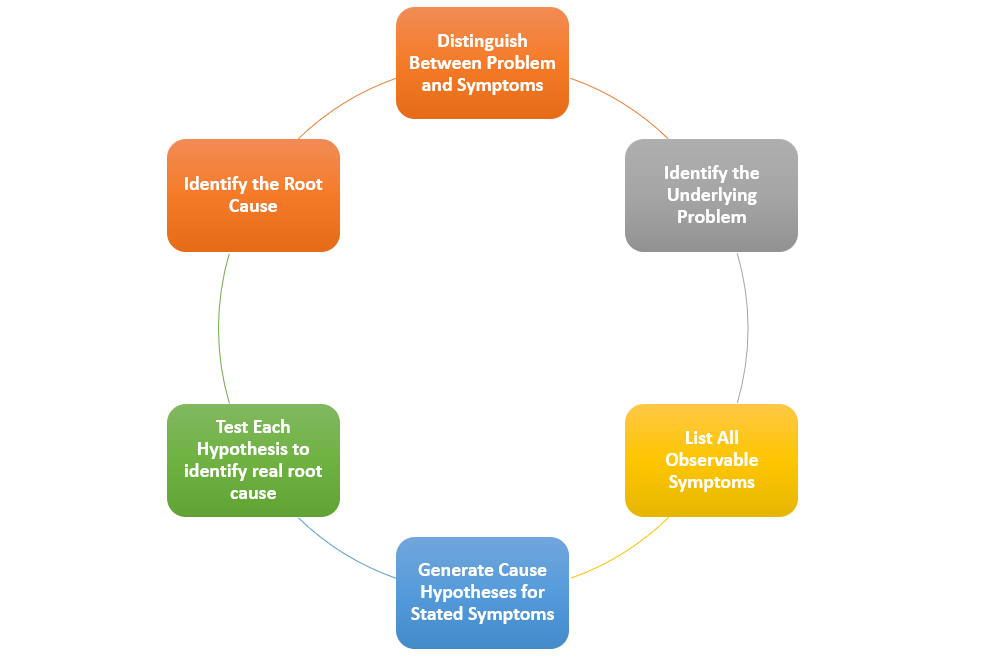
Last updated: 30th Jan, 2024
Have you found yourself stuck in a cycle of solving the same or similar problems over and over again? Ever wondered why some solutions seem to only offer a temporary fix? Have you wondered if you have identified the correct problem or if you are trying to fix one of the symptoms? The key lies in your understanding of how we define problem statements, associated symptoms, root causes, and approach to problem-solving, which is fundamentally rooted in analytical thinking and critical thinking. What exactly is the difference between a problem and its symptoms? And why is it crucial to conduct a root cause analysis to arrive at a lasting solution?
In both personal and professional spheres (workplace), the ability to identify correct problems and solve them is highly valued. Often, the issues we face are more complex than they first appear. Simply treating the visible symptoms of a problem rarely offers a lasting solution. This is where analytical thinking comes into play. Understanding the difference between a problem and its symptoms, and the role of root cause analysis in identifying and solving the actual problem, is a cornerstone of analytical thinking. This blog aims to throw light on these distinctions and demonstrate the importance of root cause analysis, empowering you to approach problems with a more analytical mindset for enduring solutions.
What is a Problem?
In the context of problem-solving, a “problem” is a situation or condition that represents the obstruction for an entity (a person or a thing) to remain in or achieve the desirable or ideal state of being. Problems can also be referred to as “challenges“. For example, a company aims to achieve a 20% increase in sales revenue by the end of the year. The problems or challenges that the company may face can be some of the following:
- Determining whether the product is not positioned correctly, and then coming up with the most apt product positioning in the manner that matches the needs of the customer
- Analyzing marketing strategy, identifying gaps, and coming up with a marketing strategy to reach out to potential customers matching the product positioning
- Create a potential customer pipeline from which X% can convert into the real ones
- Determine a sales strategy that can help make the sales to the potential customers.
- Determine the most apt communication channels for the potential customer to reach out and enquire
- Need for timely and cost-effective customer service
When the entity is moved to the ideal state (positive change) or most desirable condition, the problem stands resolved. The thing that takes the entity from an undesirable to a desirable state is called the solution.
Often, what we initially identify as a problem turns out to be merely a symptom of the underlying problem (or root cause). Symptoms of a problem can be understood as the indicators of the underlying “real problem”. Unlike symptoms, which are mere indicators or manifestations of the problem or real problem, the real problem itself is the root cause that leads to the observable symptoms. It is very important to discern between the symptom and the real problem. If not done well, there is a risk of solving the “symptoms” when you think that you are solving the problems.
Here is a problem vs symptom example. When you have a cough problem, it is important to differentiate between whether a cough is a problem and take medicines for it, or, if a cough is due to some lung problem and take the medicine to cure that lung-related problem.
Here is another example to understand problem vs symptoms. Let’s say, when a business is experiencing declining sales, one may call out the problem as “declining sales”. However, the “declining sales” is merely a symptom. The actual problem or the root cause can be traced to poor customer service based on the root cause scenario. It is the core issue that needs to be identified and resolved to bring about a positive change.
What are Symptoms? What’s the difference between Symptoms & Problems?
Symptoms of a problem are the observable effects or indicators that point towards an existing problem; they are not the problem themselves. These are the signs that something is wrong, but they often don’t reveal the underlying cause. Understanding the distinction between symptoms and the actual problem is crucial because treating symptoms won’t eliminate the root issue.
The following are some of the problem vs symptom, or, symptom vs root cause examples:
- On the personal front, let’s consider recurring headaches. You might think the problem is the headache itself, but that is a symptom. The real problem or the root cause could be anything from dehydration to stress. Taking painkillers will temporarily relieve the headache but won’t resolve the underlying issue causing it.
- In a business setting, consider declining sales. At first glance, you might think the problem is the product or its pricing. However, declining sales are a symptom. The actual problem or the root cause could be poor customer service or ineffective marketing. Addressing only the symptom by slashing prices may bring a temporary boost in sales but won’t provide a long-term solution
By identifying and treating the root cause or actual problem rather than its symptoms, you can find a lasting solution that prevents the issue from recurring. This approach not only saves time and resources but also promotes better analytical thinking and decision-making.
The following are some of the key differences between symptoms and the problems or root cause:
- Symptoms when resolved can reappear after some time. Problems or root causes when resolved stay resolved.
- Symptoms are evident. They can be easily identified. Problems or root causes are difficult to unearth or determine. They can be deep-rooted.
- A problem can manifest in the form of many symptoms.
What is Root Cause Analysis (RCA)? Why is it needed?
Root Cause Analysis (RCA) is a structured approach for identifying the underlying causes of what is referred to as the problem (symptoms on the surface). The goal is to find out what, how, and why something happened, thereby preventing recurrence. It’s like a detective’s investigation to find the “criminal” causing the symptoms, which in this context, are the undesired outcomes or challenges.
RCA is valuable because it helps you go beyond treating symptoms to find the real problem. It’s the difference between mopping up a water leak and fixing the pipe that’s leaking. By focusing on the root cause, you not only solve the immediate problem but also prevent similar issues in the future.
For instance, if a company is facing high employee attrition, addressing the symptoms might involve conducting exit interviews and providing compensation packages. However, a root cause analysis may reveal that the real issue is a toxic work culture or poor management. Addressing these root causes would lead to more effective and lasting solutions.
There are various methods for conducting RCA, and the choice often depends on the complexity of the problem and the resources available. Some popular techniques include:
- The 5 Whys: This method involves asking “Why?” repeatedly (usually five times) to drill down into the layers of a problem.
- Fishbone diagram: This visual tool allows you to categorize potential causes of a problem, helping to identify the root cause systematically.
- Analytical thinking: One can break down problems into sub-problems and continue this process until one reaches to most fundamental problems.
- First principles thinking: One can analyze a problem based on final, formal, material, and efficient causes and then repeat the process.
By understanding and applying these RCA techniques, you can develop a more analytical approach to problem-solving, thereby addressing issues at their core and preventing future recurrence.
Process for Arriving at the Root Cause of Symptoms / Problems
The following represents the process for arriving at the root cause of stated symptoms or problems:

- Distinguish Between Problem and Symptom: Your first task is to determine if what has been stated is the problem or merely a symptom of something deeper. For instance, experiencing a headache is generally a symptom, not the underlying problem itself.
- Identify the Underlying Problem: If what is stated is a problem, well and good. However, if you’ve identified a symptom, your next step is to discover what the problem could be. For example, if you’re dealing with headaches, the underlying issue may be something like ill-health.
- List All Observable Symptoms: Expand your perspective by identifying all the symptoms related to the issue at hand. This will give you a more comprehensive view and may provide additional clues about the root cause.
- Generate Cause Hypotheses for Stated Symptoms: Formulate hypotheses for what could be causing the symptoms for the identified problem. This step is essentially a diagnosis. Employ techniques like the “Five Whys” to dig deeper and identify potential underlying causes.
- Test Each Hypothesis to identify the real root cause: For each hypothesized cause, perform diagnostic tests to either validate or negate it. This could be in the form of data collection, interviews, or even controlled experiments. The aim is to gather evidence that either supports or refutes each hypothesis.
- Identify the Root Cause: After you’ve rigorously tested each hypothesis, you should be able to pinpoint one root cause that stands out as the most likely “actual problem” or “root cause” of the issues you’re observing.
Defining Problem Statement
The problem statement should consist of information related to the following:
- Ideal state: The ideal state outlines what the perfect scenario would look like once the problem is solved. This sets the vision and provides a clear goal for problem-solving efforts.
- Current state: The current state breaks down the problem into its key elements—What, Why, Where, When, Who, and How—to understand its scope and impact.
- What: Define the problem precisely. You can use root cause analysis to dig deep into the “What” aspect.
- Why: Identify why the problem is important.
- Where: Specify the areas or departments affected.
- When: Determine when the problem occurs or comes to notice.
- Who: Note who is impacted, either directly or indirectly.
- How: Describe the nature of the impact, be it financial, operational, or emotional.
- Outcome as a result of problem resolution: The outcome section elaborates on what success looks like, linking back to the ideal state. It can include quantitative and qualitative measures that indicate the problem has been solved.
Conclusion
Understanding the difference between a problem and its symptoms is the cornerstone of effective problem-solving. Many times, organizations or individuals get sidetracked by addressing symptoms without ever reaching the core issue. By employing a structured approach, like distinguishing between problems and symptoms, identifying all associated symptoms, formulating hypotheses for root causes, and rigorously testing these hypotheses, you set the stage for finding the actual root cause of the problem. This not only saves time and resources but also leads to long-lasting solutions.
From an analytical thinking standpoint, mastering this approach equips you with a crucial skill set. It helps you avoid the pitfalls of surface-level solutions and encourages a deeper understanding of challenges. So the next time you’re confronted with a “problem,” take a step back and consider: Is this the real issue, or is it just the tip of the iceberg? The answer to this question could be the first step toward effective and sustainable problem-solving.
- Coefficient of Variation in Regression Modelling: Example - November 9, 2025
- Chunking Strategies for RAG with Examples - November 2, 2025
- RAG Pipeline: 6 Steps for Creating Naive RAG App - November 1, 2025
I found it very helpful. However the differences are not too understandable for me